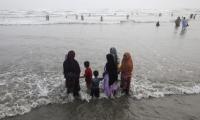LAHORE: Thousands of mourners, followers and fans Saturday attended the funeral of the 54-year-old Tehreek-i-Labbaik Pakistan chief and firebrand orator, Allama Khadim Hussain Rizvi, at Lahore’s historic Minar-i-Pakistan, undoubtedly making it one of the biggest events of its kind recorded in this Metropolis during the last 100 years.
Khadim Hussain Rizvi’s funeral was a public affair as a large number of people had poured on to the already-busy roads leading to the Minar-i-Pakistan despite COVID-19 warnings and SOPs in place.
By the way, three of these largest funerals in Lahore (Ghazi Ilm Din Shaheed, Maulana Wahab, Emir of Raiwind Tableeghi Jamaat and now religious cleric Khadim Rizvi) have incidentally been witnessed during the month of November, and in all these instances, local administration of the time had to be involved along with the respective bereaved families to keep the traffic running and maintain law and order in some cases.
Most Pakistani historians, especially those keeping an eye on the affairs and history of Lahore, would agree that the largest-ever funeral seen or witnessed in the City during the last 100 years was that of Ghazi Ilm Din Shaheed (1908-29), who had murdered an affluent Hindu book publisher named Mahashe Rajpal at Ganpat Road, next to the Urdu Bazar, for publishing a blasphemous book.
The funeral of Ilam Din was a spectacle. It was held in Lahore on November 14, 1929, though he was hanged at Central Jail Mianwali on October 31, 1929.
Quaid-i-Azam Mohammad Ali Jinnah had consented to be Ghazi Ilm Din’s defence lawyer on a special request from Allama Iqbal, who had campaigned to have the body of Ilm Din returned to Lahore for funeral as Ilmud Din had been buried by the jail authorities in Mianwali without any funeral prayers. Only after Allama Iqbal gave his assurance to the British that no riots would erupt, the permission was granted by the British Raj.
When the body of Ilm Din was exhumed from its grave, it was found to be intact without any change whatsoever. The shroud had not changed its colour. This occurred on November 14, 1929 — a full 15 days after the hanging.
After a two-day journey, the body arrived in Lahore. Muslims from the whole city and millions from adjoining areas attended his funeral. Ilm Din’s father had requested Allama Muhammad Iqbal to lead the funeral prayers, who replied that since he was a sinful person, he was not competent enough to do the job of leading the funeral prayers of such a matchless warrior.
However, as Allama Iqbal was placing Ghazi’s body inside the grave with tears oozing out of his eyes, he had reportedly remarked: "We only kept talking, the carpenter's son surpassed us in upholding the glory of the religion.”
According to some archival accounts, around 200,000 Muslims had attended the funeral prayers which were led by Imam Masjid Wazeer Khan, Imam Muhammad Shamsuddin. Some insist, the crowd number was over half a million!
Celebrated journalist Maulana Zafar Ali Khan and Dr Muhammad Din Taseer (the first Muslim PhD in the Subcontinent and late Punjab Governor Salman Taseer’s father) had also attended the funeral. Dr. MD Taseer had provided the death-bed to Ghazi Ilm Din Shaheed.
Salman Taseer was shot 28 times in Islamabad’s Kohsar Market on January 4, 2011 by a bodyguard, Mumtaz Qadri, whose own funeral in Rawalpindi — after his execution on court orders — too was attended by hundreds of thousands of people.
As stated above, after Ghazi’s case had gone to the court where Quaid-e-Azam Mohammad Ali Jinnah was his defence lawyer, Ilm Din had refused to enter a not guilty plea and said that he had acted due to extreme provocation.
Ghazi had instead insisted he was proud of his actions. This case was the only one that Jinnah had ever lost. The Sessions Court awarded Ilm Din the death penalty. Against his wishes, the Muslims lodged an appeal which was rejected.
While he was pleading Ghazi Ilm Din Shaheed’s case at the Lahore High Court, Quaid-i-Azam had stayed at the 1880 Faletti’s Hotel, which is perhaps the oldest colonial boutique hotel in Pakistan, known for hosting numerous local and foreign dignitaries including Justice Cornelius, the fourth chief justice of Pakistan, who had lived in one of its suites for more than 45 years.
Among other notable guests of the hotel are, Indian Premier Pandit Nehru, actors Ava Gardner, Raj Kapoor, Allama Iqbal, Pakistani Prime Minister Zulfiqar Ali Bhutto, singer Mohammed Rafi, Dilip Kumar and Marlon Brando, etc.
The April 29, 1976 funeral of legendary comedian Munawar Zarif (1940-76) had also attracted many thousand people. So massive was the number of participants that local administration and the deceased actor’s family reportedly had to ‘mislead’ the assembled mourners by announcing a ‘wrong’ funeral time through loud-speakers of local mosques. There was no other option as narrow winding streets and adjoining roads were jam-packed with people who wanted to attend their favourite actor’s last rites. He was the most popular and highest paid Pakistani actor of 1970s, and is considered to be one of the uncrowned kings of humour. He acted in 321 films during a 16-year career. Munawar Zareef was unable to live a longer life because of his liver problems. He was laid to rest at Bibi Pak Daman Cemetery, Lahore. Those were the PTV days and the Pakistani cinema was blooming.
The September 22, 1979 funeral of the learned Sayyid Abul Ala al-Maududi (1903-79), the founder of Jamaat-e-Islami, had also drawn a huge gathering in Lahore. Although his funeral was held in Buffalo, United States, he was buried in an unmarked grave at his Ichhra Lahore residence. His funeral prayers were led by Shaikh Yousuf Al Qardhavi at Lahore’s Qaddafi stadium. The then Pakistani ruler, General Ziaul Haq, had also attended the great cleric’s prayers in his military outfit.
Another widely-attended funeral in Lahore’s history was that of actor Sultan Rahi, who was murdered on January 9, 1996, along with his friend Ahsan, a film director. Dubbed Pakistan’s “Clint Eastwood,” Sutan Rahi and Ahsan were fixing a car tyre near Gujranwala, on way back from Islamabad to Lahore, when robbers got hold of them and sprayed bullets upon resistance. Thousands of people had thronged the busy Mall Road Lahore, the roads around the Lawrence Gardens and the Lahore Chamber of Commerce and Industry Road, when Sultan Rahi’s body was carried for final prayers. In a couple of incidents, people even trampled over each other and there was a slight stampede. Various Lollywood, stage and PTV actors, aboard a truck, had even met an accident, whereby a few of them even fell down, unable to maintain their balance in great rush and mayhem. During a career spanning 40 years, the 56-year old Sultan Rahi had acted in some 703 Punjabi and over 100 Urdu films, winning around 160 awards. He was best-paid Pakistani actor of the time. Sultan Rahi lies buried in the courtyard of revered Mughul era Sufi saint, Qari Shah Shams’ Shrine in the heart of G.O.R-1 Lahore.
On November 18, 2018, Raiwind Tableeghi Jamaat Emir, Haji Abdul Wahab, had passed away in Lahore at the age of 95 after a prolonged battle with Dengue fever. The cleric’s funeral prayer was offered after Maghrib prayers, following which he was laid to rest in a graveyard adjacent to the Tableeghi Jamaat Centre at Raiwind. Maulana Nazarur Rehman had led the funeral prayers, which were attended by a very large number of devotees, clerics and people belonging to all walks of life.
It is also worth mentioning 181 years ago, on June 27, 1839, Punjab ruler Maharaja Ranjit Singh had died of paralysis in Lahore and was cremated on June 28, 1839. Four of the Maharaja’s Ranis and seven of his slave girls followed the practice of sati and burnt themselves on his funeral pyre. Many thousands had attended this breath-taking event too.
Lt Colonel Steinbach, one of the many European adventurers who secured employment under Maharaja Ranjit Singh, had watched the funeral of the Maharaja and penned down his observations in his book “The Punjab, Being a Brief Account of the Country of the Sikhs.”
He had written: “The funeral obsequies of this extraordinary man were too remarkable not to be mentioned here. Upon his death being made public, the whole of the Sikh Sardars at Lahore assembled to do honour to his suttee, and four of his favourite queens, together with seven female slaves, having, in conformity with the horrible practice of the country, expressed their intentions of burning themselves upon the funeral pyre, preparations were immediately made for the solemnity.” Here follows an excerpt from “Tareekh-e-Punjab” by Kanhaya Lal translated into English by Muhammad Hassan Miraj: “The funeral procession was taken out from the western gate of Hazoori Bagh and it moved alongside the River Ravi, where it was placed on a heap of Chandan wood for cremation. Prince Kharaq Singh lit the fire.”
Four unidentified persons riding two motorcycles opened fire on a vehicle carrying transgender persons
Protesters are demanding immediate release of Dr Mahrang, Bebo Baloch, and all other detained members of BYC
Nadeem worries bribe of 50,000 rupees, or about $175, has only bought family of 14 a limited amount of time
Special assistant says some tourists fired aerial shots near his residence last night but there was no attack on his...
Zakat amount also surpassed official development aid received by country in 2022, amounting to Rs376bn
All Afghan citizens residing in Pakistan have been given clear instructions to return with honour







